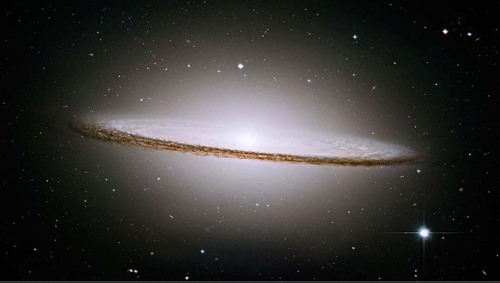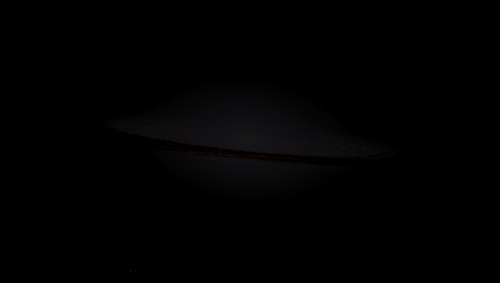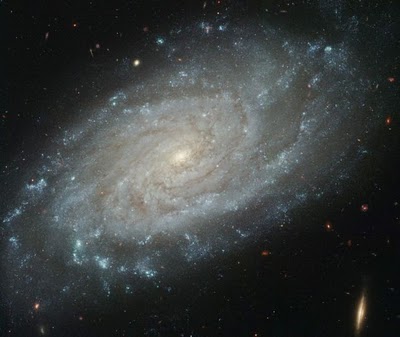We sometimes forget the conditions under which great images get made. A few years back, in one of the earliest posts on his systemic site, Greg Laughlin (UC-Santa Cruz) showed the image you see below, a famous shot made by the Hubble telescope of the ‘Sombrero Galaxy,’ M104. It’s obvious why this image is a classic. As Greg notes, “The glow of its halo makes the idea of 100 billion stars seem comprehensible.”

But look at the follow-up picture, which Greg made to demonstrate his point. While the Hubble image is a long CCD time-exposure to light gathered by a 240 cm mirror, your own eyes would deliver something considerably different. From 300,000 light years, M104 is noticeable only as a dim and lurking shape.

You can see the same effect for yourself if you find the Andromeda Galaxy, subtening an angle larger than the full Moon in our skies but as evanescent as smoke when viewed by the naked eye. The dim, fuzzy object is out there if you know where to look, but it’s not exactly impressive without a telescope.
The Intergalactic Wanderer
I used to imagine settings beyond the galaxy, where the great pinwheel of the Milky Way would dominate the sky, but you’d have to be a lot closer than Andromeda’s two million light years to get a true spectacle. Suppose, though, there were a way to leave the galaxy, something like what Ray Villard talks about in a recent article. We know that every 100,000 years or so the supermassive black hole at the galactic center ejects a star at speeds high enough to leave the galaxy. These ‘hyper-velocity’ stars are an interesting study in their own right, having velocities of over 1000 kilometers per second, compared to the more sedate 100 kilometers per second of the average star. What exactly causes a hyper-velocity star to move like this?
I checked in with the Hyper-Velocity Star Project to learn the following:
These stars are so fast that the gravitational pull of our galaxy is overcome. They reach the escape velocity and hurtle out of the galaxy. There are a few theories about what makes them achieve this velocity. They could be the result of a supernova as is believed to be the case of HVS #3 [see this article] that came from the Large Magellanic Cloud. They could be the result of a binary star system passing too close to the gravitational well of the super massive black hole at the center of our galaxy. One of the stars of the system gets caught by the huge gravity well and the other one is thrown free at very high speed achieving escape velocity.
We know of sixteen confirmed hyper-velocity stars, and the thinking is that there are about 1000 associated with the galaxy. The Hyper-Velocity Star Project is searching for more.
Into the Deepest Night
What captured Ray Villard’s attention was the idea that a Sun-like star in a binary system might be ejected, carrying its planetary system along with it. What would the civilization that arose on the surface of such a planet think about the night sky? As Ray notes, their sky would be largely black, for the receding planetary system would be near few stars as it moved beyond the halo. Ray talks about the center of the Milky Way looking like a ‘fuzzy headlamp,’ with the spiral arms, though covering a large part of sky, emerging ghostly and faint from the nucleus.
Alien sky lore would have no constellations in the absence of stars. All mythology would be built around the nighttime wispy pinwheel with its cycloptic “glowing eye.” Alien sky watchers would duly note the appearance of brilliant star-like novae and supernovae in the spiral disk. These might as first be construed as omens or messages from the gods, or fuel other superstitions. But fireworks in the galactic disk would be dutifully recorded.
As to technology, we can only speculate, but imagine what happens after this civilization develops telescopes and spectroscopy:
The development of telescopic astronomy would allow star clusters and nebulae to be resolved. It would be as big a revelation as when Galileo first observed the Milky Way in 1609. Bright blue stars would be seen sprinkled across in the Milky Way’s spiral arms. Spectroscopy would show that the pinpoints are made of the same stuff the alien’s parent star is. But it would take a great leap of imagination to connect the tiny pinpoints to the brilliant glowing orb of their star.
Emerging Science in the Void

Over the eons, our runaway civilization, bound ever outward, might notice that the galaxy that filled its skies was dimming, but would it ever be able to relate its single star to the billions on display through its newly developed instruments? Ray imagines such a society remaining pre-Copernican, but I’m not so sure. In any case, scientists that did figure out their place in the cosmos might wonder what living beings inside a galaxy would imagine, and how they would ever sort out the shape of the star swarm within which they found themselves.
Science finds its ways and I suspect our lonely intergalactic friends would eventually relate distant galaxies to the one nearest them, always wondering how they happened to be cast adrift and learning to question whether the great sky pinwheel was once home to their star. But ponder the idea of interstellar flight in this setting. Would it even be imagined? If the distance to Alpha Centauri seems almost inconceivably far to us, how much more so would the outcasts find the hundreds of thousands of light years back to the stellar city?



If the parent star was a K-class with a 20-billion year main-sequence,
the time spent being visually close to the Milky Way
would be a small fraction of this.
The most likely outcome is for such a lonely ET to arise under a truly Black Sky.
It’s a huge mercy that the chances of an ET are so cosmically low that this will never happen.
On the other hand, it would be a great SF scenario for a race to steer its home solar system into such a trajectory, in order to go to the Andromeda Galaxy in ‘only’ a billion years. It would probably require a full K-II Dyson Swarm to pull off such an audacious stunt. Once at M31 they would use stellar-wind as a rocket to slow down and stay (in a retrograde orbit). Astronomers would be hibernating during most of the ‘journey’.
Villard: “However, it is not impossible that a sun-like star in a binary system could get the boot too. It would carry along any planetary system.”
I just had to go read his article to see how he proposes that a star and its planets could stay gravitationally bound after a sufficiently violent interaction to exit the galaxy. He proposes no mechanism. I doubt that one exists, as do some of the commenters on his own article.
The two main bodies in the interaction — the two stars or one star and, say, a BH — must make a close approach to achieve the target velocity. That ought to guarantee a high gravitational gradient in which the acceleration (magnitude and direction) will be very different for each of the planets. I suspect those ejected stars are simply that — stars — but not stellar systems. Any pre-interaction planets will each go off on their own.
Anyone know if this has been quantified by someone?
I don’t know. I think at certain ranges the view could be quite spectacular. One of my outstanding memories of star gazing was one summer night in a small rowboat out in the middle of a small lake in the vicinity of Armagh Canada. I’ve seen the sky on clear nights from the high desert, the Rockies and the Alps, but I don’t remember having seen such a spectacular sky as on that night. The moon was not up, there was no light pollution and the air was clear as nothing. There were more visible stars than could be counted, but the sky was dominated by the band of the Milky Way. I’d never seen it like that before, or since. You could very easily have read a book by the light.
Now, granted, that was a view from earth. But, earth is pretty far out in the disc, about 2/3 of the distance from the center to the edge. What if the earth were a similar distance above the disc, and closer to above the galactic center. Say about 35, 000 light years above the disc. I could of course be wrong, I haven’t run any numbers or anything, but off hand it seems like the Milky Way would be a pretty spectacular naked eye view.
By the way, isn’t M 104 something like 30 Mly away, not 300,000 ly? Or did you mean that the second pic is what M 104 should look like to the naked eye if it were viewed from a distance of 300, 000 ly?
Interstellar Bill said:
Yes it would. In fact it has already been done at least once. In Larry Niven’s Known Space universe, comprising many novels and shorts, a race called Pierson’s Puppeteers do just that with their home world.
Darrell E writes:
At least those aliens could see the sky, it’s not hard to imagine a habitable planet with constant haze or cloud cover. Imagine a haze overhead that never ends as far as your society knows.
Makes for an interesting form of Intergalactic travel, which Olaf Stapledon uses – but unsuccessfully attempted – in his 1937 movel “Starmaker”. Telepathic contact has been made between our Galaxy and a neighbour, so the Galactic Community decides to propel a star-system across the intergalactic void on a multi-million year voyage. At 1,000 km/s it’d take ~750 billennia to reach Andromeda – probably a bit less since M31 is coming our way at ~200 km/s.
After so carefully arranging a binary flyby maneuver around the Core I do wonder how a star system might then be slowed down and captured in the target galaxy? Some form of drag is needed to take off the excess momentum. A Solar-sized magnetic sail? Alternatively a Criswell stellar engine might be just enough, though playing around with stars in such fashion is liable to be very, very risky.
I wonder if there’s drag on the Sun from its intrinsic magnetic field interacting with the ISM’s ambient fields?
It’s surprisingly uncertain exactly what our galaxy would look like from outside. Even the number of spiral arms is controversial. It seems pretty settled that we have a bar, so that’s something. However, estimates of circular velocity (and hence total luminosity), the scale length and the extent of the stellar disc are all over the shop.
kzb said:
Not to mention the number of stars. Estimates I have heard from legitimate astronomers and cosmologists range from 100 billion to 500 billion, or even a trillion stars.
Exactly Darrell E !
A few months back there was a new measurement of the MW circular velocity as 254km/s which got considerable publicity. This is considerably in excess of the standard velocity of 220km/s, and means more mass.
However, all the publicity mentioned was more dark matter. When in fact, by Tully-Fisher, the LUMINOSITY is proportional to v^a, where the exponent a is between 3 and 4 depending on the colour band. That’s the luminosity, not the mass.
Then there was an article that M31 total IR luminosity meant it had 1 trillion stars. The circular velocity of M31 is 257.5km/s.
So putting it all together, logically, the MW also has close to 1 trillion stars. This follows inexorably from the T-F relation and the circular velocities of the two galaxies being very similar.
N
Oddly enough, a relevant SF novel: Iain Banks’ AGAINST A DARK BACKGROUND.
Iain M Banks’ “Against a Dark Background” (the title says it all) is set in just such an intergalactic system (ejected or not). This isolation doesn’t play a big direct role in the unfolding of the twisted plotline, but it certainly does provide an existential foundation for the collective psychological state of his ancient civilisation and characters.
P
Poul Anderson’s “World Without Stars” details aliens who live on a planet circling a lonely red giant way out in intergalactic space.
Lonely stars between galaxies: http://blogs.discovermagazine.com/badastronomy/2008/01/08/aas-6-lonely-stars-between-galaxies/
I appreciate all the good pointers to SF stories that treat these ideas — my list of reading material keeps growing (though I do know the ‘Known Space’ stories and am pretty much up to speed on Niven). Anderson’s ‘World Without Stars’ somehow got past me, so it and the Banks novel now figure in future reading.
Darrell E: “… the sky was dominated by the band of the Milky Way”
That’s enviable. I live in a densely populated area of Europe and have never seen the band of the Milky Way with my own eyes :-(
I found this page searching for hypervelocity stars and “pierson’s puppeteer” after reading first, an article about the fastest hypervelocity star yet discovered (in today’s news) and another article about a newly discovered gamma-ray explosion in the center of the galaxy… put those things together and perhaps Niven’s vision of civilizations fleeing the destruction of the Galaxy is not so far fetched. Maybe those hypervelocity stars really are no accident of nature!
– Joel